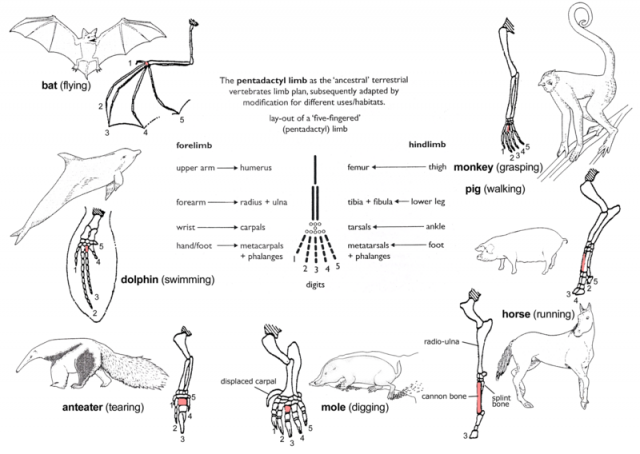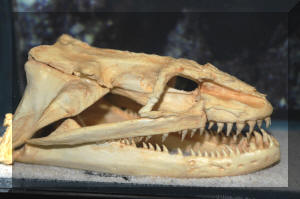Often, in transformation art, artists will either fuse digits or do something else to which my inner biologist says "no, just NO." Ignoring that this IS fantasy artwork I am talking about here, there are some people who just do not get the anatomy of humans, animals, or both. Below are the most common mistakes on my list of things that piss me off in fantasy art.
1. A paw is a hand. A fin is a hand. A wing is a hand. A hoof is a hand.
Look at your hand. Now imagine that everything else with skeletal limbs once had the same five digits.

All tetrapods - that is, all things with a bony skeleton and four limbs that are not fish - have a basic set of five possible digits attached to each of their limbs. These are numbered (by scientists, obviously) 1-5, with the thumb being #1.

Larger version here.
Breaking this one is somewhat understandable on horse transformations. After all, they only have one thickened digit on every foot. This is the pointer finger on humans, digit #3 or whatever else you would like to call the centermost digit on your hand.
The hoof is still another matter; if you look at the comparison between a simian hand and a horse's leg in the mammals-only image above, you will notice that one bone called the "cannon bone" is significantly longer on horses than it is in primates. This bone is what makes horses and other ungulates able to support themselves as they walk on their fingertips. Some people take shortcuts and not only fuse the whole human hand into one hoof, but also forget that the hand is longer and more slender on horses than on humans.
On artiodactyls - that is, even-toed ungulates such as cows, pigs, sheep, and, when in season, reindeer - there should really be no excuses for digit fusion. Those animals have two hooves (digits three and four) and two vestigial digits for a grand total of four digits on each foot. They are only lacking thumbs (digit 1 on the diagram). Again, the cannon bone is also a LOT longer in these ungulates than in primates. Hoofed animals do not walk on their toes; they walk on their toenails.

This was actually from a rather neat article about turtle shoulder bones.
This numeric rule is not just true for mammals. It is true for all things that fall under the big "tetrapod" umbrella. Since very few furries have an attraction to invertebrates, this covers the vast majority of furry work. It would do other fantasy artists good to keep this in mind as well. There is a similar issue with hindlimbs, bearing the same anatomy in mind.
2. Snakes are not all tail.
As a reptile fanatic, drakaina fangirl, and general biology nerd, nothing cheeses me off more than leg fusion in a serpentine transformation. (For one thing, fused limbs in humans is nothing short of gross - see my sirenomelia entry for details.)
No. No, no, no. A THOUSAND TIMES NO. Snakes have legs and tails just like lizards do. Here, I'll show you:
Those are vestigial legs on that python. They are attached to a tiny pelvis and everything. The vestigial legs in boids (boas and pythons) mark where the body ends and the tail begins. Snakes have short tails relative to their very, very long bodies.
(The image above is of a colubrid; no spurs, but the rest holds true.)
The remaining spurs are used primarily in mating; they can hurt almost as much as a cat scratch, and some snakes (mostly boids) have excellent control over them. They are usually longer in males than in females, and, in some species, the female lacks these diminished limbs entirely. (For those curious, the rosy boa (Lichanura trivirgata) is one of them, making rosies one of the few snakes that can be accurately sexed visually.)

The evolutionary transition from having legs to losing them was illustrated excellently by Nintendo's new Tsutarja family. Thank you, Nintendo, for doing it right.
3. All scales are the not the same.
Shoooot, where do I begin with this one? Scales are one of the oldest forms of bodily coverings after slime/mucus. They have a million different forms. There is no "one way" to draw scales. It depends on what kind of scales the creature has; fish scales are different from lizard scales are different from pit viper scales. Even then, what fish, what lizard, and what pit viper are we talking about, here?
Scale Sampler. by ~KuroKarasu on deviantART
The image above is only a small sample of the possible scale varieties that creatures could have. One of them is from a mammal. Seriously.
Rules of thumb:
Fish scales -> rounded, fall off individually.
Lizard scales -> beaded, shed in white, flaky pieces.
Boid scales -> rounded with a slight point; dewdrop-shaped. ALL snakes lack eyelids and instead have a clear scale called a brille covering the eye.
Colubrid/Elapid scales -> think elliptical diamonds.
Viper scales -> Heavily keeled; look almost like flat feathers. (If you try this on a cobra, it will look very wrong, very fast; cobras are elapids, not vipers XP)
Then we have dragons, which are a lot more like pangolins than ANY type of lizard. At first, I thought that Ciruelo and Dragonology were crazy for calling dragons mammals. Then the pangolin reminded me that, hey, it could happen.
4. According to artists, anything can have pointy sharp teeth.

What's wrong with this picture? Stegosaurus was an herbivore, that's what. There is NO reason to draw it with pointy sharp teeth that look more like they belong on a carnivorous monitor lizard. Different types of animals have different types of teeth. To be honest, most generic "carnivore" teeth look like they belong on creatures that eat fish.

Note the homogenous teeth that curl slightly backward. This is a moray eel, BTW.
Other carnivorous animals, mammals in particular, have varied teeth. Pit vipers (NOT elapids like cobras) have long, slender fangs that fold backwards into the mouth. (It's really interesting to see these in action...around professionals, of course.) T-Rex had two different kinds of teeth as well. In terms of mammalian predators, people who draw wolves and lions with nothing but sharp teeth have clearly never owned a petite carnivore.You can look on a cat or dog and prove this one wrong, people.
A gray wolf (Canis lupus) skull.
Part of this error probably stems from the notion that herbivores cannot POSSIBLY be badass. That is false; herbivores HAVE to be badass, or else the world will fall into disarray. They have claws, bulk, horns and sometimes their own teeth to make sure that only the strong predators survive and only the weak herbivores die. Evolution is an arms race, and it is only fair to acknowledge Mother Nature's full arsenal. One swift kick from a gazelle and that lion on the nature channel will never eat again.
Research your creature's dentition. Herbivores usually have flat, grinding teeth. Carnivores have pointed teeth that may or may not also be serrated like a saw's edge. Stop making things like Black Stego; I fail to see how anyone who knows ANYTHING about dinosaurs could possibly take that thing seriously.
5. Form Fits Function.
"Form fits function" is the most basic rule in the book. It can also be phrased as "does it work?" If it does not work, it will not look good. Period.
In short, horns, claws, spikes, etc. do not only have to look good, they have to work and look good. There was this one site that had a bunch of animals that had, for whatever reason, evolved their genitalia on their heads. (I got the feeling that, talented though that artist may have been, they had never gotten laid, but that's off-topic.)
How the hell does that work? Wouldn't getting it on that way be...difficult, to say the least? Oh, and messy. Giving birth so close to the mouth and brain (unless the birthing junk was elsewhere) would suck, too.
The easiest way to see if something works is to look at nature. I saw a complaint that the Dire Horse in Avatar is functionally impossible; its legs could not move well, let alone fast. Given that, on Earth, the fewer toes a creature has on the ground, the faster it is (as a general rule), I can see where having six legs would get cumbersome.
 |
| The complaint, BTW. |
In summary: If you really like animals, do research on them. Learn how they work before you turn yourself into one. That is why I can giggle a little at people who want to be wolves; in the wild, not only are wolves pack animals, but they're cowards when alone. There is a good chance that you would have to be at the bottom of the pack, not the alpha wolf, and being a lone wolf sucks. Sorry to burst your non-conformist bubble.






Bravo, bravísimo.
ReplyDeleteSeriously, this is just too awesome. I love to see "scientific explanations" of fantasy stuff.
However, people will still draw "impossible" or "unproper" anatomy. After all it's fictional, it's fantasy, it's whatever isn't real.
Thanks! :D (Sorry this is like a month late, BTW.)
ReplyDeleteYeah, I realize that, but limb structure and such should not be among those things. For example, a lot of Pokemon have three digits instead of four; that's how that world works, and I'm cool with it. At some point, with fantastic creatures in particular, you do have to flip logic the bird, but when real animals are involved, such mistakes look rather awkward.
Depends on the case... Have you ever seen "Housepets!" ? :)
ReplyDelete--Banderi